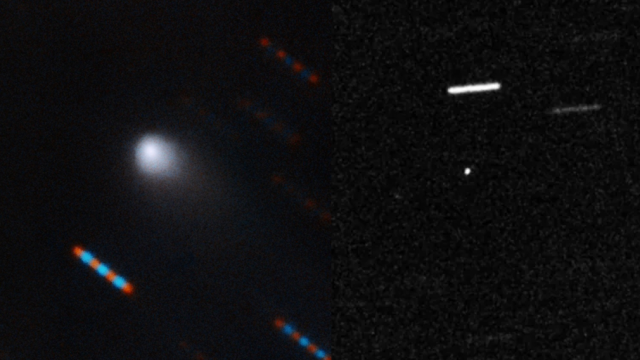The second interstellar object on record has visited our solar system, according to astronomical observations made in recent week. But how does this new visitor differ from ‘Oumuamua, the first interstellar object?
Scientists have been eager to learn more about Comet C/2019 Q4 (Borisov) since amateur astronomer Gennady Borisov first spotted it on August 31. Follow-up observations determined found that its orbit suggests it originated from outside the solar system. A comparison to the first interstellar object, ‘Oumuamua, could provide an interesting perspective on what these objects are like generally.
Astronomers discovered the first interstellar object on record, 1I/2017 U1 ‘Oumuamua, on October 20, 2017, and were able to gather hundreds of observations of the object as it whizzed through the solar system. It was strangely cigar-shaped, and seemed to accelerate as it travelled away from the Sun.
There has been some wild conjecture as to its origin and the cause of its acceleration (“aliens!”), but less speculative debate has centered around whether the object is more like a rocky asteroid or a comet that released some gas and accelerated as the Sun heated it up.
Observations haven’t seen evidence of a cometary-like tail, but “a volatile-rich gas-venting structure for ‘Oumuamua provides the simplest explanation for its odd trajectory,” according to a paper in The Astrophysical Journal.
Comet C/2019 Q4 (Borisov) has slightly different features — for one, initial observations have already revealed a comet-like coma and tail. Its orbit looks different as well. “It has the kind of orbit that’s more characteristic of what we expected to see [from an interstellar object,]” Matthew Holman, director of the Minor Planet Centre, told Gizmodo last week. “‘Oumuamua made a really deep plunge into the solar system and came close to the Sun; that’s not the typical behaviour that we might expect.”
Astronomers expect interstellar objects to be more like icy comets than rocky asteroids because of where they’re presumed to have formed in their own star systems. “As you go out from the star, the disk is cooler, so the objects have more ices in them,” Kat Volk, associate staff scientist at The University of Arizona, explained to Gizmodo. They’re presumed to be more like the icy objects in our solar system’s own distant Kuiper belt. “Most of the stuff that gets ejected would have more ice it.”
Astronomers also think that the object is a little larger than ‘Oumuamua, though the hazy coma makes it hard to tell Comet C/2019 Q4 (Borisov)’s shape, Volk said.
Observatories have only just gathered enough evidence to conclude the object likely has interstellar origins, and watching it has been (and will continue to be) difficult, since at present, it’s relatively close to the Sun in the sky from our viewing angle on Earth. But thankfully, the object is travelling in toward the Sun, which means we’ll have more time to observe it, versus ‘Oumuamua, which was caught on its outbound journey.
And scientists are hoping for more interstellar objects soon.
“A sample size of two is really small, but it’s better than a sample size of one,” Volk said. “We’ll keep learning about them as we catch more of them zooming through.”
